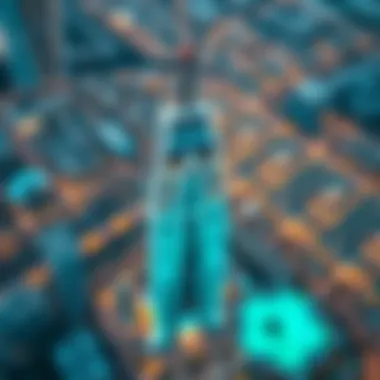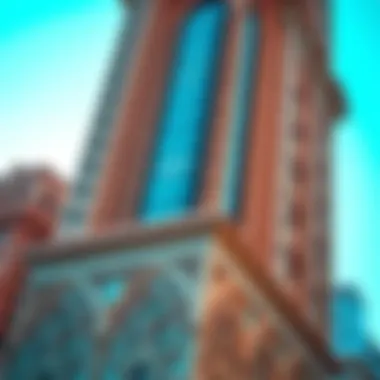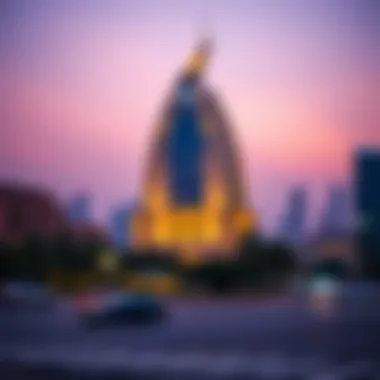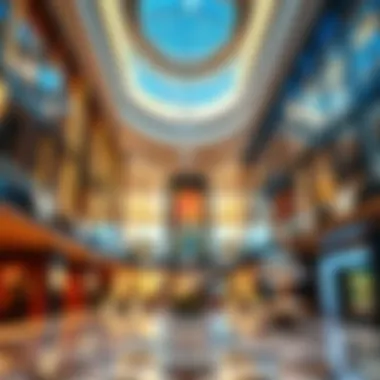Al Maktoum Building: A Cultural Icon of Dubai


Intro
The Al Maktoum Building stands as more than just a structure in Dubai; it is a testimony to the evolution of architectural and cultural identity in the region. As one strolls through the bustling streets of this vibrant city, the building captures the essence of both history and modernity. Intricately designed, it represents not only cutting-edge technology but also serves as a bridge connecting generations and communities in Dubai.
The landmark draws interest from various sectors, including expats, tourists, and real estate agents, all intrigued by its historical importance and contributions to the local community. The Al Maktoum Building offers a unique perspective on how architecture can shape a city’s narrative while reflecting the lifestyle and ethos of its people.
Understanding the Al Maktoum Building requires a deeper look into its neighborhood, where history intertwines with contemporary dynamics to create a lively tapestry of culture. This exploration will delve into various elements such as architecture, community engagement, cultural influences, and the building’s role in shaping Dubai’s urban landscape.
The following sections will outline the neighborhood, lifestyle perks, and the opportunities that the Al Maktoum Building presents to both residents and visitors alike.
Prologue to the Al Maktoum Building
The Al Maktoum Building holds a central position in the architectural and cultural sphere of Dubai, making it a significant point of reference when discussing the emirate's rapid transformation. This building is more than just a structure; it symbolizes a blend of modern innovation and the rich narrative of local heritage. As we delve into this exploration, it's essential to grasp the importance of understanding the building's historical roots and architectural characteristics. The Al Maktoum Building has become a landmark that encapsulates the spirit of Dubai, marrying traditional elements with contemporary trends.
In this article, we will take a closer look at how this building reflects the broader historical and cultural contexts of Dubai. This includes examining its design features, its role within the community, and the impact it has had on surrounding urban development. Given the growing importance of cultural landmarks in fostering community identity, the Al Maktoum Building stands tall, representing a bridge between the past and the ever-evolving present.
Historical Significance
The historical importance of the Al Maktoum Building is vast. Constructed in a period when Dubai was transitioning from a small trading port to a global city, the building is a testament to this metamorphosis. It was erected during a time when the city was laying the groundwork for its future, making it symbolic of the aspirations of the people. The architectural choices made during the building's design can be viewed as a reflection of the cultural dialogue happening at the time, showcasing influences from both local traditions and international styles.
This building not only represents an era of economic boom but also serves as a record of the socio-political shifts that were taking place. It invites observers to appreciate how the past informs the present, and how architecture acts as a silent narrator of a place's history.
Architectural Overview
The architectural essence of the Al Maktoum Building is both striking and thought-provoking. It showcases a unique fusion of traditional Islamic motifs and modern design principles. The use of intricate geometric patterns and lush ornamental elements pays homage to the rich heritage of the region, while its innovative use of glass and steel speaks to the futuristic vision Dubai embodies.
The building's facade is often noted for its stunning interplay of light and shadow, with expansive windows that allow for natural light to bathe the interior spaces. The design emphasizes not only aesthetic appeal but also functionality, allowing for fluid movement within the structure.
"The Al Maktoum Building is not just an architectural feat; it is a living testament to Dubai's journey and aspirations."
Additionally, the layout encourages community interaction, reflecting a commitment to social integration within urban environments. This blend of the old and the new makes the Al Maktoum Building a striking visual landmark and an essential part of Dubai's architectural narrative.
Cultural Context
Understanding the role of the Al Maktoum Building in Dubai's cultural landscape is crucial to appreciating its significance beyond mere bricks and mortar. This building is not just an architectural marvel; it's steeped in layers of meaning and social relevance that resonate with both residents and visitors alike.
Symbolism in Architecture
The Al Maktoum Building embodies the confluence of tradition and modernity, acting as a canvas for various architectural symbols that reflect Dubai's journey from a small fishing village to a global hub of commerce and innovation. One prominent feature is the mashrabiya, a traditional architectural element that promotes ventilation and privacy, symbolizing the merging of old-world charm with contemporary design. The building’s façade, is often praised for its intricate detailing—each line and curve tells a story of Dubai's past and its ambitions for the future.
While the aesthetic appeal of the Al Maktoum Building is undeniable, it serves a deeper purpose in its design. Architects consider the cultural implications of space and light, engendering a sense of community and engagement among visitors. The openness of public areas encourages socialization and interaction, serving as a physical manifestation of Dubai's commitment to fostering a diverse and dynamic society. This deliberate inclusion reflects a contemporary allegiance to heritage, echoing the fabric of the city's ethos.
The Al Maktoum Building is a testament to the cultural evolution of Dubai, showcasing how architecture can maintain a dialogue between history and progress.
Role in the Community
The significance of the Al Maktoum Building extends beyond its aesthetic qualities; it's a community gathering place that nurtures local culture. With multiple spaces designated for exhibitions, community events, and educational workshops, this building plays an important role in promoting the arts and cultural exchange. It stands as a beacon of creative expression, attracting local artists and international talent alike.


Moreover, the building's strategic location near bustling markets and cultural centers fortifies its role as a community hub. Here, families gather, tourists explore, and locals convene, creating a vibrant atmosphere that pulsates with life and energy. This mixture of residents and visitors not only enriches the community but also fosters understanding and appreciation of different cultural expressions.
In summary, the Al Maktoum Building represents much more than a mere structure; it serves as a cultural touchstone for Dubai. By marrying compelling architecture with community engagement, this landmark instills pride in locals while inviting a greater global audience to experience its dynamic cultural narrative. It is this dual role of artistry and practicality that continues to solidify the building's place in the heart of Dubai's ever-evolving urban landscape.
Design Elements
The design elements of the Al Maktoum Building not only define its aesthetic appeal but also serve as an integral part of Dubai's architectural narrative. They represent a fusion of traditional influences and modern innovation, showcasing a delicate balance between functionality and artistry. These elements breathe life into the structure, encouraging both local and international admiration. The architectural style, along with the materials and construction techniques, plays a crucial role in the overall impact of the building on its environment.
Architectural Style
The architectural style of the Al Maktoum Building stands as a beacon of modernism merged with cultural roots. It reflects a combination of contemporary design principles and local traditions. The use of geometric patterns and ornamental motifs seen on the façade instantly draws attention. This choice not only pays homage to the rich Islamic architectural heritage but also integrates seamlessly with the surrounding skyline.
Incorporating large glass panels, the building enhances natural light, creating vibrant interior spaces that encourage creativity and interaction. The sleek forms and sharp lines project a sense of progress and sophistication. This is more than just a structure—it's a statement; it symbolizes Dubai's ambitious vision and economic vitality.
Key Features of the Architectural Style:
- Use of traditional Arabic patterns
- Integration of glass and steel for a modern twist
- Serene landscaping that complements the building's silhouette
- Flexible interior layouts for varied community use
With its striking silhouette, the Al Maktoum Building not only captures the essence of modern architecture but also serves as a backdrop for community events and gatherings. Aesthetic considerations like these are important because they help to foster a sense of identity and belonging among residents and visitors alike.
Materials and Construction Techniques
The construction of the Al Maktoum Building leverages a mix of sustainable materials and advanced techniques that showcase local craftsmanship. High-performance concrete is often used, which ensures durability and efficiency in the building's energy consumption. Incorporating locally-sourced materials minimizes the carbon footprint—a nod to more environmentally conscious practices.
Additionally, the building employs cutting-edge construction techniques such as modular design, which allows for rapid assembly and reduced waste. This approach not only expedites the building process but also facilitates future renovations and expansions, ensuring longevity in a rapidly evolving urban landscape.
Benefits of Using Specific Materials:
- Enhanced thermal performance
- Resistance to harsh environmental conditions
- Contribution to local economic growth through sourcing
In essence, the materials and techniques used in the Al Maktoum Building's design reflect a commitment to sustainability while also celebrating the craft of local artisans. These design elements work hand in hand to create a structure that is not only functional but also profoundly resonant within the cultural and physical landscape of Dubai.
Impact on the Surrounding Area
The Al Maktoum Building is not just another structure in the skyline of Dubai; it serves as a catalyst for urban transformation and socio-economic enhancement in its vicinity. Its presence has spurred urban development, reshaping the area around it from mere commercial zones into vibrant community hubs while also uplifting commercial vitality, providing opportunities for local businesses to thrive.
Urban Development
The architectural prominence of the Al Maktoum Building has propelled urban development in a region previously characterized by simple frameworks and traditional markets. Since its completion, there has been a noticeable uptick in infrastructural advancements. New high-rise buildings, verdant parks, and improved pedestrian pathways have emerged, illustrating how the Al Maktoum Building acted like a lighthouse amidst a developing sea.
Planning authorities have recognized that structures like the Al Maktoum Building play an integral role in shaping urban policies. By drawing in tourists and promoting local culture, the area has seen a surge in interest from real estate developers. This sparked a ripple effect, leading to initiatives such as:
- Enhanced transportation links
- Development of mixed-use space combining residential, commercial, and recreational areas
- Investments in public art and green landscaping
These initiatives not only attract visitors but also offer locals a chance to engage more with their surroundings, solidifying the Al Maktoum Building's role in urbanization.
Commercial Vitality
The Al Maktoum Building hsa also revitalized the commercial vitality of its surroundings, providing a bustling environment with many business opportunities. The opening of cafes, artisan shops, and marketplaces has created a thriving atmosphere that invites both locals and tourists. This influx has reshaped consumer culture, as the building acts as a magnet for foot traffic. Businesses capitalizing on this increased traffic have noted:


- Rise in customer engagement and sales
- Partnership with local artisans for cultural authenticity
- Opportunities for global brands to establish their presence
Moreover, the dynamic atmosphere fosters a sense of community; people come together not just as customers but as participants in a communal experience. This interaction has the potential to transform a once-silent neighborhood into a lively cultural district.
"The Al Maktoum Building is more than a landmark; it’s a key player in the economic playbook of Dubai’s evolution."
In summary, the impact of the Al Maktoum Building goes beyond its structural grandeur. It captivates attention and rallies support for the community, making it a pivotal asset in both urban and commercial development.
Events and Activities at Al Maktoum Building
The Al Maktoum Building is more than just a feast for the eyes; it's a hive of activity that pulses with the energy of various events and activities throughout the year. This aspect not only showcases the building’s architectural grandeur but also enhances its social footprint within the community. In a city like Dubai, known for its rich tapestry of cultures and traditions, the events hosted at the Al Maktoum Building serve as a crucible where art meets architecture, igniting a vibrant dialogue between its historical significance and contemporary relevance.
These activities contribute enormously to the cultural fabric of Dubai, providing an essential platform for artists, musicians, and community leaders to share their craft. They represent an intersection where locals and expatriates come together, creating a sense of belonging and shared experience that transcends mere visitation.
Cultural Festivals
Cultural festivals at the Al Maktoum Building form a central part of its identity. These festitivals reflect a melange of influences, showcasing everything from traditional Emirati dances and art forms to international performances. Each festival focuses on celebrating diversity and encouraging cross-cultural engagement. For instance, during the Emirates Festival of Literature, attendees can immerse themselves in discussions with authors, workshops, and interactive sessions that provoke thought and inspire creativity.
Moreover, these festivals often underline important themes such as sustainability or inclusivity, sparking meaningful conversations that resonate well beyond the event itself.
Some noteworthy examples include:
- Dubai Food Festival: Highlighting not just Dubai's diverse culinary scene but also promoting local chefs and restaurants, creating a platform for local cuisine.
- Art Dubai: A dynamic showcase of contemporary art, attracting artists and attendees from all over the globe, enveloping the building in creative energy.
- National Day Celebrations: Colorful exhibitions and performances that mark the proud history and heritage of the UAE, fostering national pride.
"Cultural festivals at the Al Maktoum Building provide an outstanding opportunity for communities to come together, engage in shared experiences, and celebrate the beauty of diversity."
Exhibitions and Installations
Exhibitions and installations within the Al Maktoum Building add depth to the architectural experience. These curated shows often feature local and international artists, presenting a range of mediums from fine art to multimedia installations. The versatility of the building’s spaces allows for innovative displays that can transform the viewer's perception, challenging preconceived notions about art and architecture.
Some prominent exhibitions include:
- Photography Month: Featuring local photographers and their interpretations of life in Dubai, this event highlights the unique perspectives present in the city.
- Traditional Emirati Crafts Show: An exhibition dedicated to showcasing artisanship that represents the heritage of the UAE, supporting local craftspeople and ensuring that traditional techniques remain vibrant and relevant.
- Contemporary Art Installations: Artists pushing boundaries with interactive installations invite viewers to move through space, often blurring the line between spectator and participant.
These exhibitions not only serve an educational purpose but also bolster engagement, making art accessible to a broader audience. In fact, many exhibitions include workshops, talks, and guided tours, enriching the visitor experience even further.
Together, the events and activities at the Al Maktoum Building weave a vibrant narrative, underscoring its role as a cultural epicenter in Dubai. As it continues to evolve, the building remains a beacon for community involvement, artistic expression, and cultural celebration.
Navigating to the Al Maktoum Building
The Al Maktoum Building is not just an architectural marvel; it is also centrally located, catering to both locals and tourists alike. Understanding how to navigate to this landmark is crucial. It opens the door to exploring Dubai's vibrant culture, shopping spots, and culinary experiences.
Access and Transportation
Getting to the Al Maktoum Building is fairly straightforward. For those using public transport, the Dubai Metro is a reliable option. The nearest station, Al Jafiliya, is just a short walk away. The metro is not only efficient but also economical, giving you a chance to see city life unfold outside your window.
If you prefer to take a taxi, just tell the driver the name of the building, and they'll drop you right at the entrance. Ride-hailing services like Uber and Careem are also widely used and can offer a hassle-free experience.


For those who like to drive, the building is well-marked and accessible via major roads. There is ample parking, but be mindful of the regulations. Dubai can be a fast-paced city, so keep an eye out for road signs.
"Public transportation is the veins of the city. When you know where to go, the journey becomes part of the adventure."
Surrounding Attractions
Once you’ve made it to the Al Maktoum Building, a world of exploration awaits. The surrounding area is bustling with attractions that enhance the cultural experience.
- Dubai Museum: Just around the corner, this museum provides a fascinating perspective on Dubai's transformation over the years.
- Al Fahidi Historic District: Feel the pulse of the past in this area. Stroll through narrow lanes and discover art galleries and cafes in restored buildings.
- Dubai Creek: A short walk takes you to the Creek, where you can take a traditional abra ride. It’s the best way to see the city from a different angle.
- Souks: Explore the gold and spice souks, where the aroma of spices fills the air, and you can purchase exquisite jewelry.
In essence, navigating to the Al Maktoum Building serves as a gateway, connecting you not only with the structure itself but also with the living history and culture of Dubai.
Preservation and Future Prospects
Preservation of historical landmarks like the Al Maktoum Building plays a crucial role in maintaining the cultural fabric of a city. As Dubai continues to evolve rapidly, the challenge remains to honor its architectural heritage while accommodating the demands of modern urban life. This balance brings to light important discussions surrounding both conservation efforts and future developments, ensuring that the Al Maktoum Building remains relevant and respected for generations to come.
Conservation Efforts
Conservation efforts for the Al Maktoum Building are not merely about maintaining its structure but also encompass a deeper commitment to preserving its essence and significance. A multidisciplinary approach often guides these efforts, involving historians, architects, and environmentalists working together to devise strategies that safeguard the building's architectural integrity while enhancing its aesthetic appeal.
- Historical Preservation: This aspect emphasizes the need to retain original materials and design elements. Specialists often undertake meticulous restoration work, where they replace deteriorated materials with replicas based on historical records, ensuring authenticity is maintained.
- Community Engagement: Engaging local communities in conservation efforts fosters a sense of ownership and pride in the heritage site. Workshops and educational programs can be organized, allowing residents and visitors to learn about the building's storied past and the importance of its upkeep.
- Sustainability Practices: Modern conservation practices have started integrating sustainability. Utilizing eco-friendly materials and energy-efficient technologies during restoration can not only help preserve the building but also reduce its environmental footprint and operational costs.
These combined efforts can ensure that the Al Maktoum Building is not just a relic of the past, but a vibrant part of Dubai's present and future.
Future Developments
Looking ahead, the future developments around the Al Maktoum Building promise to enhance both its visibility and accessibility. As the city grows, urban planners work on innovative strategies to harmonize new structures with existing historical landmarks.
- Nurturing Accessibility: Improving transport links, such as dedicated tram lines or pedestrian pathways, can make visits easier for both tourists and residents. The integration of the building into local public transport systems will increase foot traffic and encourage more people to engage with the site.
- Cultural Programming Expansion: Expanding the range of programs hosted at the building can attract diverse audiences. Plans for more varied cultural events can stimulate interest, drawing in art lovers, history buffs, and families alike. For instance, hosting regular workshops, art installations, or thematic festivals could amplify the building's role in the community.
- Technology Integration: Employing digital technologies can breathe new life into historical exploration. Interactive applications, augmented reality tours, or virtual exhibits can give visitors an immersive experience, blending history and innovation seamlessly.
"By focusing on preservation and integrating future developments, the Al Maktoum Building can thrive in Dubai's vibrant cultural landscape."
As the city continues to grow, so too does the opportunity to redefine how we appreciate and engage with its architectural gems. The Al Maktoum Building, with its rich heritage, stands to benefit immensely from thoughtful preservation and future-forward developments.
Finale
The conclusion serves as more than just a wrap-up; it encapsulates the essence of what the Al Maktoum Building signifies within Dubai's diverse urban tapestry. This architectural marvel is not merely a structure, but a testament to the emirate’s commitment to blending tradition with modernity. Emphasizing both the history and the forward-thinking design elements, this perusal aims to solidify the building's standing as a cornerstone of Dubai’s cultural narrative.
Summary of Insights
Throughout this examination, several key points emerge about the Al Maktoum Building. First and foremost, its historical significance is undeniable. The building is a reflection of the rapid development that Dubai has undergone over the decades, representing a pivotal moment when the city began to solidify its identity on the world stage. Furthermore, the architectural style marries traditional Arabic influences with contemporary design ethos, showcasing a unique aesthetic that attracts both locals and global visitors alike.
Additionally, the cultural context surrounding the building enriches its narrative. The symbolism within its design fosters a sense of belonging and pride among residents. The events hosted at this landmark—ranging from cultural festivals to art exhibitions—widthdraw the community together, illustrating its role as a social hub.
In terms of impact, the Al Maktoum Building has been a catalyst for commercial growth in the area. Its presence has influenced surrounding developments, contributing to a vibrant urban atmosphere. The building also showcases ongoing efforts for preservation, ensuring that it remains a key part of Dubai’s future as it evolves and adapts amid relentless urban expansion.
Final Thoughts on the Al Maktoum Building
As we weigh in on the future of the Al Maktoum Building, we are reminded that its significance stretches far beyond aesthetics. It is a living, breathing part of Dubai's landscape—a symbol of resilience and progress. With continued conservation efforts and an eye towards future developments, it promises to remain a focal point of cultural exchange and community engagement.
The Al Maktoum Building is an irreplaceable part of not just the skyline, but also the soul of Dubai, capturing the authentic spirit through its stone and structure. Its unique blend of function and form serves as a reminder that in the face of rapid advancement, the delicate balance between heritage and innovation continues to play a critical role in shaping our urban world.
In closing, the Al Maktoum Building stands as a powerful narrative of what can be achieved when we honor the legacy of our past while looking confidently toward the future.
For more insights on Dubai's architectural brilliance, consider visiting Wikipedia or reading articles from Britannica about its comprehensive historical context.



